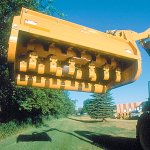Yeah, well now I have to go out and flip my mower over (not currently mounted on the 3pt) to count for myself tomorrow. :confused2: I know I have 28 sets of knives (2 per station). I guess that does not allow simple division by 3 or 4 and therefore I guess there is some assymmetry. Too dark to check right now.
I understand your point I just don't understand why they don't simply balance the flail stations so that any number of flails will work. If you consider a centrifuge, they are balanced so that if you put the same weight in all stations the centrifuge is balanced regardless of how much weight you add. I don't see why flail makers would not use that same principle. If you think about it, flails lose weight as they wear. That means they will become progressively out of balance if they are in balance only with fresh flails as shipped from the factory. However, if they are in balance so long as each flail weighs the same (and flail knives do generally wear equally over time) then it would remain in balance as knives wear and would also be in balance if you changed all the knives to a different style. Seems odd to me that they wouldn't do that.


